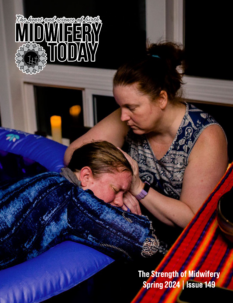
Photo by Aida Jeddi
Thoughts on Prenatal Care
Midwifery Today, Issue 148, Winter 2023
Join Midwifery Today Online Membership
I would like to share my thoughts on prenatal care, which I believe can start before the woman is even pregnant as she prepares her body for her pregnancy.
Let’s break the care given during and for a pregnancy into several points: 1) What is pregnancy care? 2) When does it begin and how long does it last? 3) Is the care different for different laboring and birthing places chosen or needed? 4) How are emotional care and/or needs addressed in a pregnancy? 5) What does prenatal care look like and modify when a change is necessary due to an issue in the pregnancy/labor?
Prenatal care is the care given to a woman while pregnant. It includes checkups and prenatal testing. That care can be from a doctor, physician assistant, nurse, CNM, CPM, DEM, or the woman herself. (I include all types of midwives in the DEM title, as there are many routes to midwifery.) The three components of prenatal care are: risk management, health promotion and education, and therapeutic intervention. Risk management is care given to reveal hidden health, physical, or mental issues. Health promotion and education is teaching pregnancy terms and schedules of care and testing, and offering of diet suggestions and childbirth classes. Therapeutic intervention can be the suggestions to address bodily pain or a baby in a wrong position.
Pregnancy care usually starts at five to six weeks for a doctor/physician assistant/nurse/CNM office visit and eight weeks for a CPM/DEM visit. Prenatal care ends with the birth of the baby. Postpartum care starts for a period of six weeks, with various numbers of checkups for the mom and the baby. Women are usually seen once a month until the 34th or 35th week of pregnancy (of a normal gestation of 37 to 42 weeks), then seen at 36 or 37 weeks, and then weekly. If the pregnancy goes over 40 weeks, weekly non-stress tests are done to evaluate placental function and baby’s movement, using fetal heartbeat and its responsiveness (movements).
Pregnancy care can vary a lot, with some OB practices wanting to do two to three ultrasounds, glucose testing, and, of course, CBC testing, with more tests later in the pregnancy. For some women, this provides security that everything in their pregnancy is okay. Other women, who are going to a birth center or having a homebirth, may prefer to not have all the testing or only part of it. Some choose prescription drugs over homeopathics, herbs, or essential oils. Birth center care can be a mix between of normal obstetrical care and homebirth midwifery care.
I have not seen emotional care or needs addressed in most OB practices, except in early or late pregnancy to explain emotional changes. I’m not saying there are not compassionate doctors and nurses who care for the emotional needs of the women they see; they do. It is not common for emotional needs to be part of the prenatal care given in today’s obstetrical practice. I believe it is different in practices with CNMs, but is still limited depending on how busy they are. (In my area alone, two hospitals have closed their obstetrical units and another local hospital recently lost a three-obstetrician office, when they moved out of state, very quickly, with short notice.)
At an OB appointment, a nurse checks the patient in, performs tests for pulse, blood pressure, oxygen level, and urine and asks if there are any changes. After a wait, a doctor comes in to measure the fundal height, do a fetal heartbeat exam and ask about any questions. This usually takes only 15 minutes, as opposed to the full hour that most CPMs and DEMs schedule for a more complete prenatal visit. In that visit, the practitioner asks how the mother feels and how the baby is moving, checks pulse, blood pressure, hemoglobin, and urine. That Is followed by a fundal measurement, determination of baby’s position, and a fetal heartbeat check. All of this is done by the same person (who often wears regular clothing), in a warm space, with a comfortable chair, in a slow-paced, more non antiseptic environment. This can make a difference, especially for those women who have “white coat” syndrome, where their pulses and blood pressures go up from anxiety of being in a hospital-like setting or from past bad experiences.
Everyone involved in a birth wants the birth to go well, without any problems or complications. Because such situations do come up, a backup plan is needed from the start of prenatal care. I tell couples I serve in my homebirth practice:, Plan A: you have a wonderful homebirth, Plan B: something comes up in the pregnancy or labor and we transfer to the hospital, and Plan C: the baby needs a C-section to be born safely. I also have the same plan, if I am going to help a couple in a scheduled hospital birth. They have their birth plan, which has been shared and approved by the doctor, and we go to the hospital when in labor or for induction. My backup hospitals know me and my “style” of helping woman labor and birth. We work well as a birthing team for this laboring person and baby or babies. Even in the hospital situations come up and I help the couple/person emotionally shift and rethink their birth plan and desires, according to the situation. It is so important to have a knowledgeable person at the hospital to explain technical terms or meanings and emotionally help with processing the changes happening—sometimes very quickly. Some issues are not life-threatening or serious, just different for the woman, like a change in shift or a baby changing its position and compressing its cord or during a labor with an epidural, when suddenly the room is flooded with more people and a lot more noise and voices to help change the woman’s body position. (I once had this happen at 3;00 am, when the room doors burst open with four nurses coming in to whip the sheet off the sleeping woman. They picked her up and changed her position, because the baby’s heartbeat had suddenly gone very low. They told her what they were doing as they repositioned her, which totally changed the baby’s heartbeat. A good move, but confusing at the time.)
As of September 28, 2023, I will have been a midwife for 45 years. There have been a lot of changes during that time. When I first started out as a midwife, I always asked permission for anything I did, especially touching. I started out doing the typical initial consultation and then asked the clients to pray or think about me being their midwife, because another midwife might be better suited for them. If we mutually agreed that we were a good fit, they came back for the first prenatal care visit. That care included pulse, blood pressure, urinalysis, finger poke for hemoglobin, a check for edema, a starting weight and current weight, and, finally, a fundal height and heartbeat checks. Later, I would include the baby’s position in the chart. Before I checked the fundal height and heartbeat I always said to myself, “Oh, baby, I wonder what you’re going to teach me and what will this woman/couple and labor and birth teach me.”
I always charted in the sidelines anytime I heard something different, which is how I discovered the various different sounds in the uterus. For example, you can hear the echo of the fetal heartbeat vs. the true fetal heartbeat, the placenta. You can also hear a true knot in the cord, if the umbilical cord is lying against her abdominal wall—that was a fascinating find for me.
When we were done with that part of the prenatal care, we went back to the sitting space and talked about what was written down about this visit, and whether there were any questions. (The information gathered by the midwife is “shared” information, but really belongs to the client.) This part of the visit provides a great opportunity to teach the woman/couple/family about what is happening in the pregnant woman’s body and what will happen in labor, birth, and postpartum. I spent a fair amount of time talking about what a pregnancy diet looks like and helped people make changes in their diet and talked about any special needs, such as food allergies or sensitivities, hypoglycemia, diabetes or gestational diabetes, and twin births. I can spend two hours with someone who has body or birth anxiety just listening and softly answering questions—emotional prenatal care, to partner with the physical prenatal care. This is so important, on so many levels, for. us as “birthing humans.”
There was a period in the 80s, where it seems like my practice was separated into three areas: my regular English practice, Mennonite and Amish families, and women coming to me for healing births, some from out of state. Some of their prior births had been traumatic for them. During this time, I realized that I had a new belief in the understanding of birthing women.
God made women, the heart and hearth of the home. He also made women’s, brain, hearts and lady parts. There are times with trauma or fear, where you have to minister to the brain by giving it true information about our bodies, labor, or birth. It helps to obtain hospital/birth records and go over them with her, to explain or point out areas where she was not listened to or was betrayed by past birthworkers. I have heard some very traumatic birth stories and seen some very traumatized women. These women will carry that trauma into the next pregnancy, birthing both the traumatic baby and the present baby in this current pregnancy, labor, and birth. In the same way we have to minister to a woman’s heart and help her believe her body can have a baby—to open that door to instinctual birth. She needs help to understand that this is a different birth, but you believe her words of the past experience and what it did to her. You take baby steps in your relationship, at times where the woman leads the conversation and topics. Please understand that her words or fears are not so much directed at you as at the past, and you now stand in a place/gap where you can heal the deep emotional wound that is in her. You may still be working on those wounds when she’s in labor, birth, and postpartum, because you never know exactly where the fear(s) or the wounds happened in her and to her in the past. I know understand that if you minister to the brain or the heart, that helps unlock her lady parts so her pelvic floor muscles aren’t tightly protecting her and the baby and she can release her baby.
One of our goals as midwives Is to protect the birthing woman/couple and the birth itself. (In one birth, a woman and I created “safe words” to use if she felt she was losing control of her emotions or not understanding what was happening at the time. It worked well, as she was having a hospital birth.) That’s our passion or purpose, to individualize each birth, for each woman. Because if you help one woman, especially a primip, you can influence her daughters and her granddaughters. So many generations that we can midwife to and for. We must also think of the next generation of midwives coming behind us, coming beside us, to teach natural instinctual birth, from conception to postpartum. I personally believe that there are four parts of prenatal care—the fourth being the postpartum—and that it should be extended for three months, rather than doing two or three visits after a baby is born to check on the mom and the baby.
Midwifery has changed so much since I was at my first birth and I gave birth to my first baby. So much fear and more technology used. Let us be the guardians of birth, remembering that Midwife means being with woman. We must remember that birth is sacred ground and we are the guardians of birth. Birth is just as private and Intimate as the creation of that child. I wish you well.

 Mary L. Cooper, CPM, mother of three, one being a son with Down Syndrome, who has been one of her greatest teachers, and two grandchildren. Helping over 4000 births, recently into three generations, still practicing and learning.
Mary L. Cooper, CPM, mother of three, one being a son with Down Syndrome, who has been one of her greatest teachers, and two grandchildren. Helping over 4000 births, recently into three generations, still practicing and learning.














